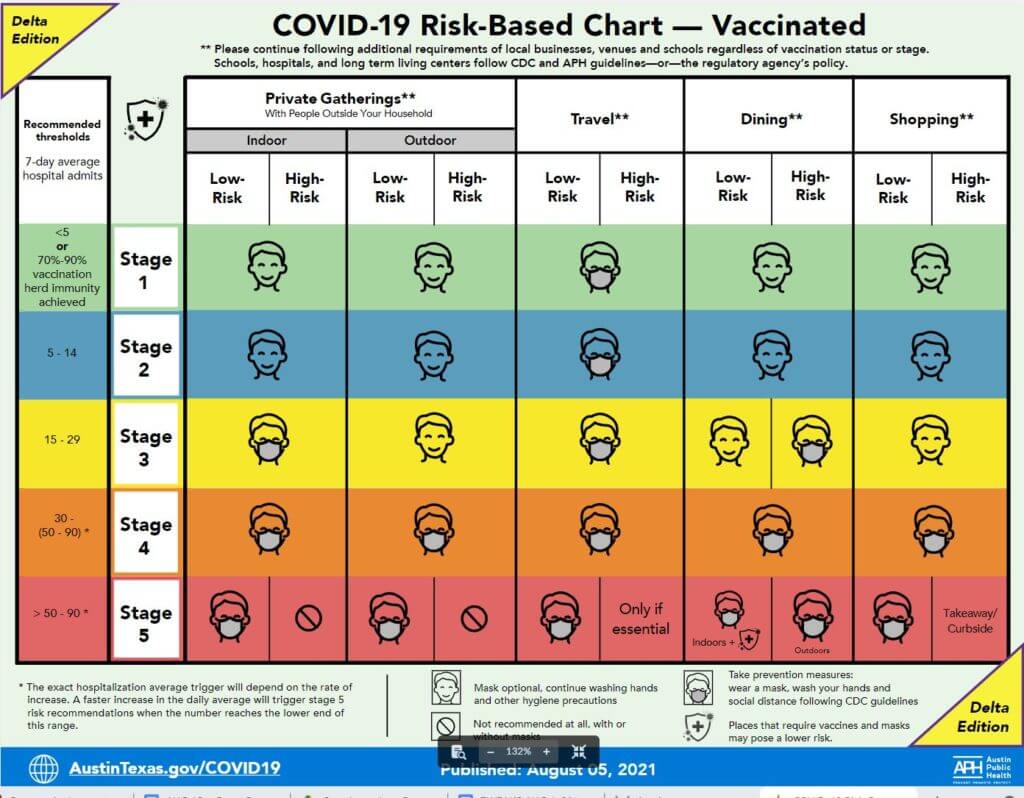Austin Public Health (APH) has published a color-coded chart to help residents of Austin-Travis County understand the stages of risk and provide recommendations on what people should do to stay safe during the COVID-19 pandemic.

For vaccinated individuals the recommendations are as follows for Stage 5:
| Stage 1: Participate in indoor or outdoor private gatherings and dine or shop without precautions. Travel with precautions. |
| Stage 2: Same recommendations as Stage 1. |
| Stage 3: Same recommendations as Stage 1. |
| Stage 4: Participate in indoor or outdoor private gatherings, dine or shop, and travel with precautions. |
| Stage 5: For high-risk individuals, indoor and outdoor private gatherings are not recommended at all, with or without precautions, travel is discouraged unless essential, dining should be outdoors with precautions, and shopping should be outdoors or takeaway or curbside.For low-risk individuals, indoor and outdoor private gatherings, travel, shopping, and dining should be with precautions. Note that places that require vaccines and masks may pose a lower risk. |
Additional protective measures are recommended for people who are partially or not vaccinated.
For example, partially or not vaccinated individuals should take precautions for all activities in Stages 1 through 5. In Stage 3, high-risk individuals, namely those aged over 65 or people with underlying health conditions, should avoid all activities unless essential. And in Stages 4 and 5, all partially or not vaccinated individuals, regardless of risk should avoid most activities unless essential. It is recommended that shopping and dining be takeaway and/or curbside.

Austin area moves to Stage 5 risk as COVID-19 hospitalizations continue to soar
By MARISA CHARPENTIER, KUT
Austin and Travis County have moved into Stage 5, the highest level of risk in the local health department’s Covid-19 guidelines.
Dr. Desmar Walkes, Austin-Travis County Health Authority, said during a news conference Thursday that this is the fastest Covid-19 surge in the pandemic so far. Patients in intensive care units across Central Texas are sicker and hospitalized longer, she said.
“Getting vaccinated is your best possible defense and significantly reduces your chance of getting extremely sick, being hospitalized or dying,” she said.
With most older adults already vaccinated, the surge has been particularly affecting younger people. Health providers are seeing more Covid cases among children under 12, who cannot be vaccinated, and life support machines are being used on patients as young as 19, Walkes said.
The spike in cases has also put a strain on the local health system’s resources. In addition to increasingly low ICU space, hospitals are having to deal with a shortage of staff to provide care, Walkes said.
Covid-19 hospitalizations have been rising sharply in the last few weeks, spurred by the highly contagious Delta variant and stagnant vaccination rates. Austin Public Health has raised its Covid-19 risk assessment twice in the last month.
APH looks to Covid-19 hospitalization numbers to determine the local risk level. The five-county region (Travis, Williamson, Hays, Bastrop and Caldwell) is reporting an average of 63 new hospitalizations per day, three times what it was seeing in mid-July.
Hospitals and health care workers are overwhelmed. Local officials said last week that intensive care unit capacity in the area has been dangerously low. The number of ICU beds available in the 11-county region that includes Austin has been fluctuating around 14. That means there are 14 ICU beds for an area with 2.3 million residents.
To keep cases down, APH is issuing the following guidance under Stage 5.
Unvaccinated and partially vaccinated people should:
- Get vaccinated.
- Stay home as much as possible and avoid gatherings and traveling.
- Choose curbside pickup and delivery options.
- Wear a mask if they leave home.
Fully vaccinated people should:
- Wear a mask, wash hands and continue to social distance during private gatherings.
- Avoid gatherings and travel only when it’s essential if they have underlying conditions and are at high-risk of severe illness.
- Encourage others to get vaccinated.
The vast majority of people being hospitalized for Covid-19 are unvaccinated, according to health officials. A lot more of them are under the age of 50, too.
“The choice now becomes vaccination or a ventilator for our young people who may have been stubborn about going to get that vaccine,” Walkes said earlier this week. “We need to now spend time talking one-on-one and educating people about vaccine safety.”
So far, about 64 percent of Travis County residents 12 and older are fully vaccinated against Covid-19. In Texas as a whole, about 53 percent are.
Governments and state agencies in Texas can’t mandate people get vaccinated or wear masks under an executive order from Gov. Greg Abbott. Any entity that breaks the order faces fines.
Though he has acknowledged vaccines are “the most effective defense against the virus,” the governor claims “the path forward relies on personal responsibility rather than government mandates.”
School districts cannot mandate masks either, which has parents concerned as the school year is set to start in a few weeks. Some districts, like the Austin and Round Rock independent school districts, have decided to provide a virtual option this fall. But the measure will stretch their budgets since it won’t be funded by the state like it was last school year.
Some officials are going around Abbott’s order. Houston Mayor Sylvester Turner said Monday that city employees will be required to wear masks in city buildings where social distancing isn’t possible.
The Austin Independent School District announced Thursday that despite the governor’s order, it would require masks on school buses.
Businesses in Texas can still require customers to wear masks.
President Joe Biden on Tuesday called out Abbott and other state leaders who have enacted orders prohibiting vaccine and mask mandates. He said Abbott’s order was the “most extreme” of its kind.
“What are we doing?” he asked. “Covid-19 is a national challenge. And we have to come together, all of us together, as a country to solve it.”

